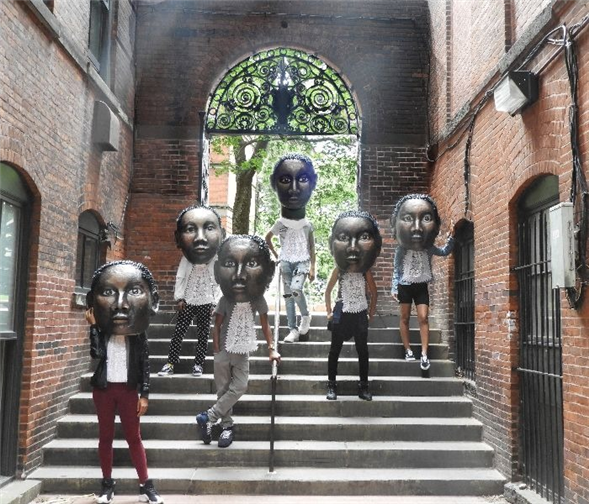Translate Page

Theodora Skipitares' new spectacle celebrates a pair of African Americans pioneers
---
In an exchange of letters with Thomas Jefferson in 1791, Benjamin Banneker—a free black man, independent farmer, self-taught astronomer and mathematician—argued for racial equality. Jefferson responded: "Nobody wishes more than I do to see such proofs as you exhibit, that nature has given to our black brethren, talents equal to those of the other colors of men."
Their historic back-and-forth is recited verbatim in The Transfiguration of Benjamin Banneker, a play by Theodora Skipitares at La MaMa, but the scene features a surreal flourish. As the actors portraying Jefferson and Banneker deliver their dialogue, two teenage members of the Soul Tigers Marching Band engage simultaneously in a drum battle.
A prolific visual artist, writer and theatre director, Skipitares has been mounting new "puppetry epics" roughly every 18 months for the past 40 years. So it's no surprise that The Transfiguration of Benjamin Banneker includes dozens of puppets; it's the marching band that distinguishes the work from anything else she's created. Indeed, the percussionists are the "quirky" reason the play even came to be.
It all started when Skipitares, a professor at Pratt Institute in Brooklyn, attended the inauguration of the school's new president. At the ceremony, the all-male Soul Tigers performed along with an all-female dance troupe.
"They were thrilling," she recalls—so much so that she went up to them afterward and asked, "Who are you and where are you based?" They explained they were from the neighborhood, just two blocks away at the Benjamin Banneker Academy public high school.
That's how Skipitares became interested in Banneker. "I started reading up on him—he was fascinating," she says. "He envisioned other solar systems besides ours; that theory wasn't proven until the 1940s. I was struck by what a unique individual he was—and by his partial erasure because of his race."
Initially, she thought about organizing a parade in his honor featuring the Soul Tigers and the dancers wearing giant puppet heads of Banneker. But "the whole thing kind of grew and grew," she says. She started collaborating on the puppets with Benjamin Banneker Academy's art teacher, Matthew Mecca, and student volunteers. "It became as much of a session in peer bonding as it was about making the art," Mecca says. The show's choreographer, Edisa Weeks, also met regularly with the school's dance teacher, Francie Johnson, and her pupils. "They gained confidence as the choreographer often asked the dancers for input," Johnson says of her students. "They also had fun, especially playing with the hula hoops for one of the scenes."
{Image1}
The Transfiguration of Benjamin Banneker is now an elaborate piece of theatre featuring nine dancers, seven drummers, five puppeteers, composer LaFrae Sci playing live original music and 35 to 40 puppets—"not like the old days when I had 300!" Skipitares says. It's her first biographically inspired play since 1991's The Radiant City, her acclaimed work about New York City's master builder Robert Moses and her only show to transfer Off Broadway. "I would love a chance to move more shows," Skipitares says. But she believes that "if you do something that's not traditional, it scares people."
Certainly her latest opus isn't a straightforward biography; Banneker isn't even its sole focus. Astronaut Frank Borman and Lieutenant Uhura from Star Trek put in appearances, and about half the play skips ahead to the 20th century and explores the life of Ed Dwight, an Air Force test pilot who trained to become the first African-American astronaut, but never got a chance to go to space. He ended up resigning from the military and becoming a sculptor. He's made more than 120 monuments to African-American historical figures, and embarked on an unsuccessful 14-year effort to create a Banneker memorial in Washington D.C. For the play, Skipitares interviewed Dwight, now 86 and living in Denver. "I just picked up the phone and called him," she says.
Skipitares concedes there is a lot going on in The Transfiguration of Benjamin Banneker—especially for an hour-long play. "I think I am a collage artist," she says. "I associate things together. I'm hoping they all tie together."
While puppetry is always part of her artistic mélange, it's not what she expected to be doing when she moved to New York 50 years ago and got a graduate degree in theatre design. Initially, she worked as a costume and set designer while pursuing a solo performance career. She wore her own unusual ensembles on stage—one was made of 3,000 walnut shells. For one piece, "I did a sculpture of myself, and did a mold so there were 30 of me," she recalls. "I brought them on to the stage as a way of having other performers." She ended up cutting joints into the arms of one of the sculptures, attaching strings and suddenly a puppet maker was born. Puppetry has been driving her aesthetic ever since, and she thinks she knows why.
"It's the visual splendor, the fantastical imagery," she says. "The research I do for a play is always very literal. The puppets, I'm hoping, make it more powerful."
---
TDF MEMBERS: At press time, discount tickets were available for The Transfiguration of Benjamin Banneker. Go here to browse our current offers.
Jonathan Mandell is a drama critic and journalist based in New York. Visit his blog at NewYorkTheater.me or follow him on Twitter at @NewYorkTheater. Follow TDF at @TDFNYC.
Top image: The Benjamin Banneker chorus. Photo by Jane Catherine Shaw.